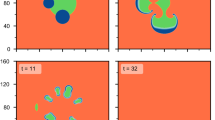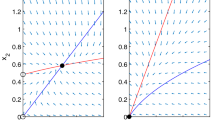Abstract
We study the induction and stabilization of spiral structures for the cyclic three-species stochastic May–Leonard model with asymmetric predation rates on a spatially inhomogeneous two-dimensional toroidal lattice using Monte Carlo simulations. In an isolated setting, strongly asymmetric predation rates lead to rapid extinction from coexistence of all three species to a single surviving population. Even for weakly asymmetric predation rates, only a fraction of ecologies in a statistical ensemble manages to maintain full three-species coexistence. However, when the asymmetric competing system is coupled via diffusive proliferation to a fully symmetric May–Leonard patch, the stable spiral patterns from this region induce transient plane-wave fronts and ultimately quasi-stationary spiral patterns in the vulnerable asymmetric region. Thus, the endangered ecological subsystem may effectively become stabilized through immigration from even a much smaller stable region. To describe the stabilization of spiral population structures in the asymmetric region, we compare the increase in the robustness of these topological defects at extreme values of the asymmetric predation rates in the spatially coupled system with the corresponding asymmetric May–Leonard model in isolation. We delineate the quasi-stationary nature of coexistence induced in the asymmetric subsystem by its diffusive coupling to a symmetric May–Leonard patch, and propose a (semi-)quantitative criterion for the spiral oscillations to be sustained in the asymmetric region.
Graphic abstract











Similar content being viewed by others
Data Availability Statement
This manuscript has no associated data or the data will not be deposited. [Authors’ comment: All data are presented within the figure files.]
References
R.M. May, Stability and Complexity in Model Ecosystems (Princeton University Press, Princeton, 1973)
J.M. Smith, Models in Ecology (Cambridge University Press, Cambridge, 1974)
J. Hofbauer, K. Sigmund, Evolutionary Games and Population Dynamics (Cambridge University Press, Cambridge, 1998)
J.D. Murray, Mathematical Biology I. An Introduction (Springer, New York, 2002)
D. Neal, Introduction to Population Biology (Cambridge University Press, Cambridge, 2018)
S.E. Kingsland, Modeling Nature (The University of Chicago Press, Chicago, 1985)
S. Schuster, J.U. Kreft, A. Schröter, T. Pfeiffer, J. Biol. Phys. 34, 1 (2008)
J.H. Mattei, I. Hanski, O. Gaggiotti, Ecology, Genetics, and Evolution of Metapopulations (Elsevier Academic Press, Amsterdam, 2004)
M.Y. Kim, R. Roy, J.L. Aron, T.W. Carr, I.B. Schwartz, Phys. Rev. Lett. 94, 088101 (2005)
T.R. Malthus, An Essay on the Principle of Population (J Johnson, London, 1798)
P. Vineis, M. Berwick, Int. J. Epidemiol. 35, 1151 (2006)
M.C. Cross, P.C. Hohenberg, Rev. Mod. Phys. 65, 851 (1993)
M. Cross, H. Greenside, Pattern Formation and Dynamics in Nonequilibrium Systems (Cambridge University Press, Cambridge, 2009)
M. Mobilia, I.T. Georgiev, U.C. Täuber, J. Stat. Phys. 128, 447 (2007)
T. Butler, N. Goldenfeld, Phys. Rev. E 80, 030902 (2009)
T. Butler, N. Goldenfeld, Phys. Rev. E 84, 011112 (2011)
U.C. Täuber, J. Phys. A Math. Theor. 45, 405002 (2012)
U. Dobramysl, M. Mobilia, M. Pleimling, U.C. Täuber, J. Phys. A Math. Theor. 51, 063001 (2018)
H. Matsuda, N. Ogita, A. Sasaki, K. Satō, Prog. Theor. Exp. 88, 1035 (1992)
J.E. Satulovsky, T. Tomé, Phys. Rev. E 49, 5073 (1994)
L. Frachebourg, P.L. Krapivsky, E. Ben-Naim, Phys. Rev. Lett. 77(10), 2125 (1996)
L. Frachebourg, P.L. Krapivsky, E. Ben-Naim, Phys. Rev. E 54(6), 6186 (1996)
Q. He, M. Mobilia, U.C. Täuber, Phys. Rev. E 82, 051909 (2010)
Q. He, M. Mobilia, U.C. Täuber, Eur. Phys. J. B 82, 97 (2011)
S. Rulands, A. Zielinski, E. Frey, Phys. Rev. E 87, 52710 (2013)
A. Szolnoki, M. Perc, New J. Phys. 17, 113033 (2015)
A. Szolnoki, M. Perc, Sci. Rep. 6, 38608 (2016)
R. May, W. Leonard, SIAM J. Appl. Math. 29, 243 (1975)
D. Labavić, H. Meyer-Ortmanns, J. Stat. Mech. Theory Exp. 2016, 113402 (2016)
P.P. Avelino, B.F. de Oliveira, R.S. Trintin (2021). arXiv:2104.14276
D. Bazeia, B. de Oliveira, J. Silva, A. Szolnoki, Chaos Solitons Fractals 141, 110356 (2020)
T. Reichenbach, M. Mobilia, E. Frey, J. Theor. Biol. 254, 368 (2008)
T. Reichenbach, M. Mobilia, E. Frey, Nature 448, 1049 (2007)
S.R. Serrao, U.C. Täuber, J. Phys. A Math. Theor. 50, 404005 (2017)
G. Szabò, G. Fáth, Phys. Rep. 446, 97–216 (2007)
A. Szolnoki, M. Mobilia, L.L. Jiang, B. Szczesny, A.M. Rucklidge, M. Perc, J. R. Soc. Interface 11, 20140735 (2014)
A. Szolnoki, B.F. de Oliveira, D. Bazeia, EPL (Europhys. Lett.) 131, 68001 (2020)
M. Blahota, I. Blahota, A. Szolnoki, EPL (Europhys. Lett.) 131, 58002 (2020)
M. Perc, A. Szolnoki, G. Szabó, Phys. Rev. E 75, 052102 (2007)
A. Szolnoki, M. Perc, EPL (Europhys. Lett.) 92, 38003 (2010)
J.M. Smith, Evolution and the Theory of Games (Cambridge University Press, Cambridge, 1982)
S. Serrao, Ph.D. thesis, Virginia Polytechnic Institute and State University (2020). http://hdl.handle.net/ 10919/101782
Acknowledgements
We are grateful to Michel Pleimling and Priyanka for fruitful discussions and helpful comments. M. Lazarus Arnau contributed to a preliminary study concerning a distinct system of coupled ecologies, which in part motivated the present work. This research was sponsored by the Army Research Office and was accomplished under Grant no. W911NF17-1-0156. The views and conclusions contained in this document are those of the authors and should not be interpreted as representing the official policies, either expressed or implied, of the Army Research Office or the U.S. Government. The U.S. Government is authorized to reproduce and distribute reprints for Government purposes notwithstanding any copyright notation herein.
Author information
Authors and Affiliations
Contributions
Both authors conceived and planned this study. S.R.S. wrote the Monte Carlo code, carried out the numerical simulations, performed the quantitative data analysis, and generated the figures. U.C.T. aided in the interpretation of the results. Both authors jointly prepared the manuscript.
Corresponding author
Rights and permissions
About this article
Cite this article
Serrao, S.R., Täuber, U.C. Stabilizing spiral structures and population diversity in the asymmetric May–Leonard model through immigration. Eur. Phys. J. B 94, 175 (2021). https://doi.org/10.1140/epjb/s10051-021-00168-x
Received:
Accepted:
Published:
DOI: https://doi.org/10.1140/epjb/s10051-021-00168-x




